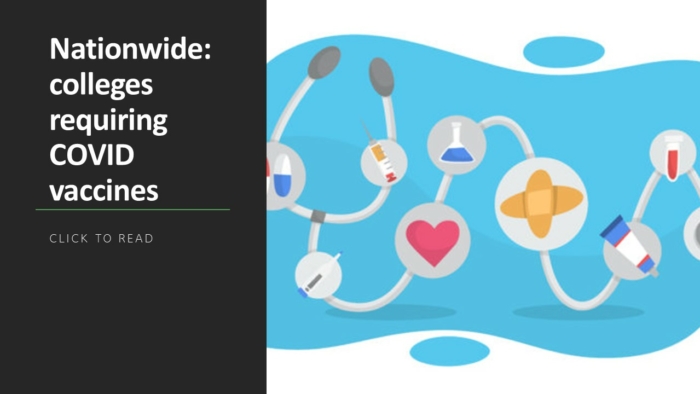With cases across the country and in New York state freefalling over the first two months of the year, Cornell University officials made the decision in early March to ease mask requirements on campus. What could go wrong?
A week after it lifted its mandate for certain indoor settings, there was a massive surge in positive COVID-19 test results. There are now 462 active cases plus 35 on the employee side, prompting Cornell to raise its alert level to yellow (higher prevalence than predicted). And while the university isn’t going back to mandating masks, it is strongly advising its student body to wear them as they head to high-traffic areas.
“This rising transmission is likely due to a number of factors, including relaxing mask requirements, the emergence of the BA.2 variant, and increased social activities,” Provost Mike Kotlikoff and two other leaders wrote to the Cornell community. “While the health impacts of infection remain mild for those who are fully vaccinated/boosted, the academic disruption and isolation housing requirements for infected students make it necessary for us to respond to this increase in COVID spread.”
The mention of the BA.2 variant, or stealth, is notable given its rise across the globe and even in the United States, where it now comprises 30-35% of new cases. Public health experts have cautioned that it likely will become the dominant strain here because of its high transmissibility. In the state of New York, the upbeat trends have reversed course over the past two weeks, and cases are up 69%. But so far, few institutions in the state and across the U.S. have reported significant upticks of COVID.
In fact, across town at Ithaca College, it currently has only four active cases among students. The entire State University of New York system is showing a less than 0.6% positivity rate from the collective tests it has done at its 63 institutions in the past week. The best news of all is that the system has had one fatality in the entirety of two years of the pandemic out of 18,000 positive cases. So is Cornell is simply an outlier or a sign of things to come?
Right now, there is no indication of that next tidal wave hitting institutions, but that could change. And if it does, will they be able to hold off another pesky subvariant in BA.2 and remain in unmasked modes as spring breaks end and students return to campuses? University Business looked at several states that are showing an increase in COVID positive cases over the past two weeks to see how their big universities are faring.
Kentucky: As COVID cases have fallen just about everywhere, the state is continuing to see unexpectedly high numbers in many counties for a whopping 110% increase in positive COVID tests, according to New York Times data. However, some of the largest institutions are keeping the virus at bay. Kentucky State University has had just three new cases in the past seven days. The University of Kentucky has had barely any cases over the past month. And the University of Louisville’s positivity rate, meanwhile, is at 1.43%, the lowest in more than a month.
More from UB: Why a phased approach to masking is working for one big university
Colorado: Even where positive tests are up 28% statewide over the past two weeks, two big universities have seen almost no surge yet of the stealth variant, which is said to be comprising 20% of cases. The University of Colorado at Boulder has had less than 10 cases of COVID in each of the past three weeks. Colorado State University had a big spike of 400 cases on Jan. 18 but has been trending downward since. Its dashboard will bear watching because it has not been updated since students returned from spring break on March 21 and since a mask requirement was lifted. The University of Denver is back this week after break but hasn’t seen much COVID activity since January, when return testing showed a more than 10% positivity.
Massachusetts: In a state where cases have risen 27% in the past two weeks, COVID has been tougher to track since some colleges have abandoned their reporting on COVID dashboards. MIT showed a combined 240 positive cases of COVID in students and employees across the past two-week reporting period, a number that continues to fall during the semester (it posted more than 1,900 in the first two weeks of the year). During the previous week (March 20), Boston University conducted more than 19,000 tests and its positivity rate was just 1.08%. Like so many other institutions, the numbers are down tremendously from early January, when 423 COVID cases were identified in a single day.
Washington D.C.: The area has posted a 20% increase in cases recently, and some institutions are seeing their numbers go up. American University’s 65 positive cases from Mar. 14-20 were the highest since a month before that. Still, that is only a 1.8% positivity rate. Both Georgetown and Howard University’s rates were almost the same during that stretch. It will be interesting to watch to see how those numbers all change when new reporting comes in.
One positive is that health officials in Israel, which has experienced a spike in stealth cases, say that this omicron variant is reacting like its predecessor, with less severe outcomes than Delta. More than four million people in the country have received third COVID doses and the country will likely hit a million who have gotten fourth doses soon. Only 62% of those in the eligible 18-24 age group have gotten two vaccine doses in the U.S., though many colleges are reporting much stronger numbers across their populations.









